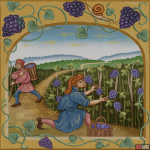Text
Vineyards have had a tradition in Europe since ancient Greece, but it was in the Middle Ages that this noble profession truly flourished. ![]() Wine was brought to Bohemia by
Wine was brought to Bohemia by ![]() Charles IV, who had developed a taste for it in France and wanted it cultivated in our region. It was at the end of the 14th century that vineyards were established in Kuttenberg, Mělník, and Prague. The spread of vines was also facilitated by the warmer climate during the Middle Ages, allowing cultivation in otherwise agriculturally uninteresting locations (dry, rocky areas).
Charles IV, who had developed a taste for it in France and wanted it cultivated in our region. It was at the end of the 14th century that vineyards were established in Kuttenberg, Mělník, and Prague. The spread of vines was also facilitated by the warmer climate during the Middle Ages, allowing cultivation in otherwise agriculturally uninteresting locations (dry, rocky areas).
You would have difficulty finding the familiar taste of today’s wine in medieval wine. Due to the lack of preservatives, spices or honey were added to the wine, and it was often diluted with water because it was consumed throughout the day. Only with the discovery of the sulfur wick was it possible to properly disinfect barrels and preserve wine for longer periods, allowing for the abandonment of flavorings and preservatives.
The vineyards themselves were most commonly planted on southern (sunny) slopes. The wine was either grown as a low bush or trained to climb poles. The modern system of wire “rows” was not yet used. Work in the vineyard was year-round. Pruning was done twice a year, the vineyards were often hoed, and pests and fungal and mildew diseases had to be managed. The peak of the season was the harvest and the subsequent marathon of processing the berries, including pressing, straining, decanting into barrels, and then wine fermentation. Each monastery or private winemaker had their own carefully guarded procedures and methods.


No Comments